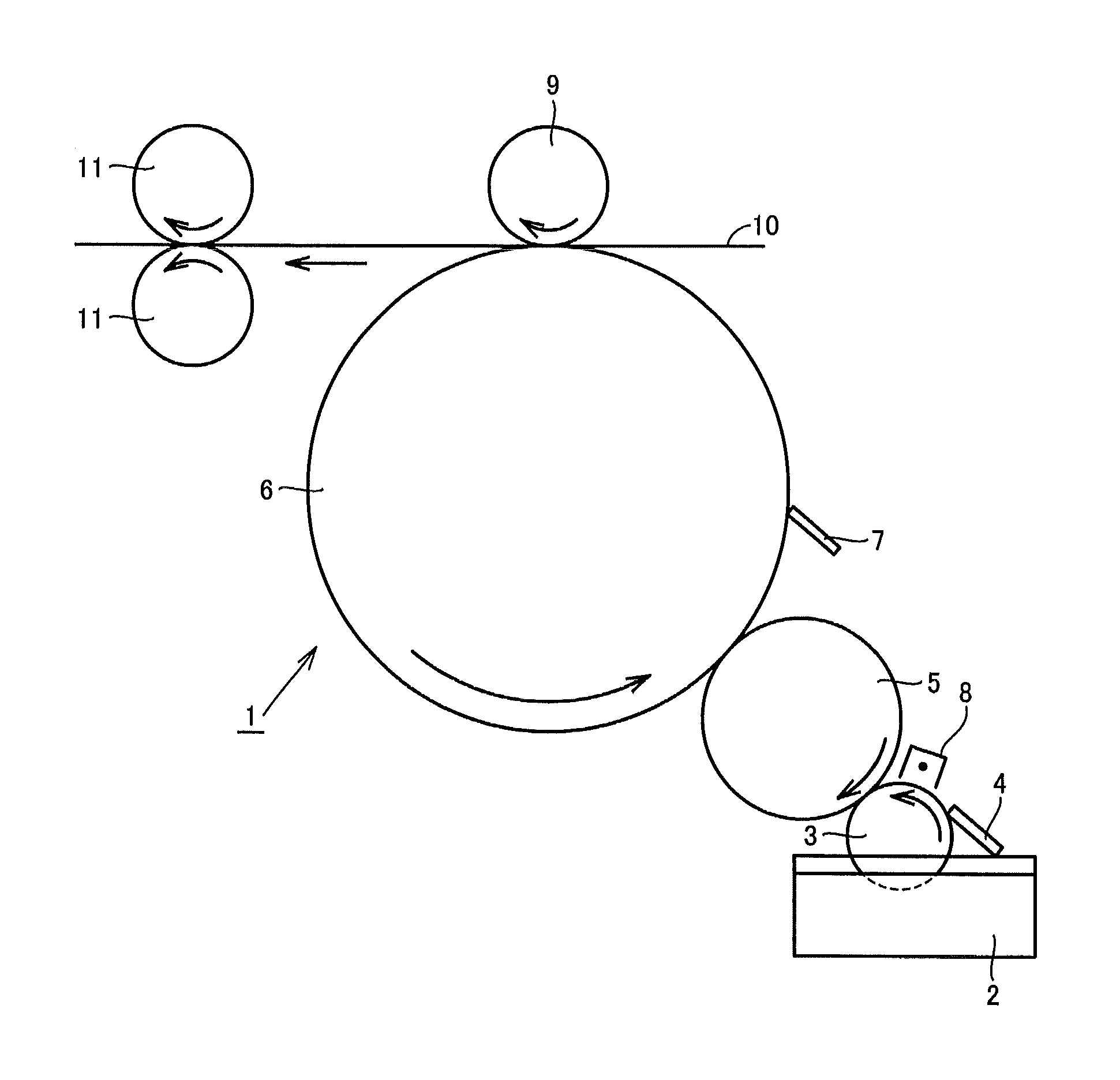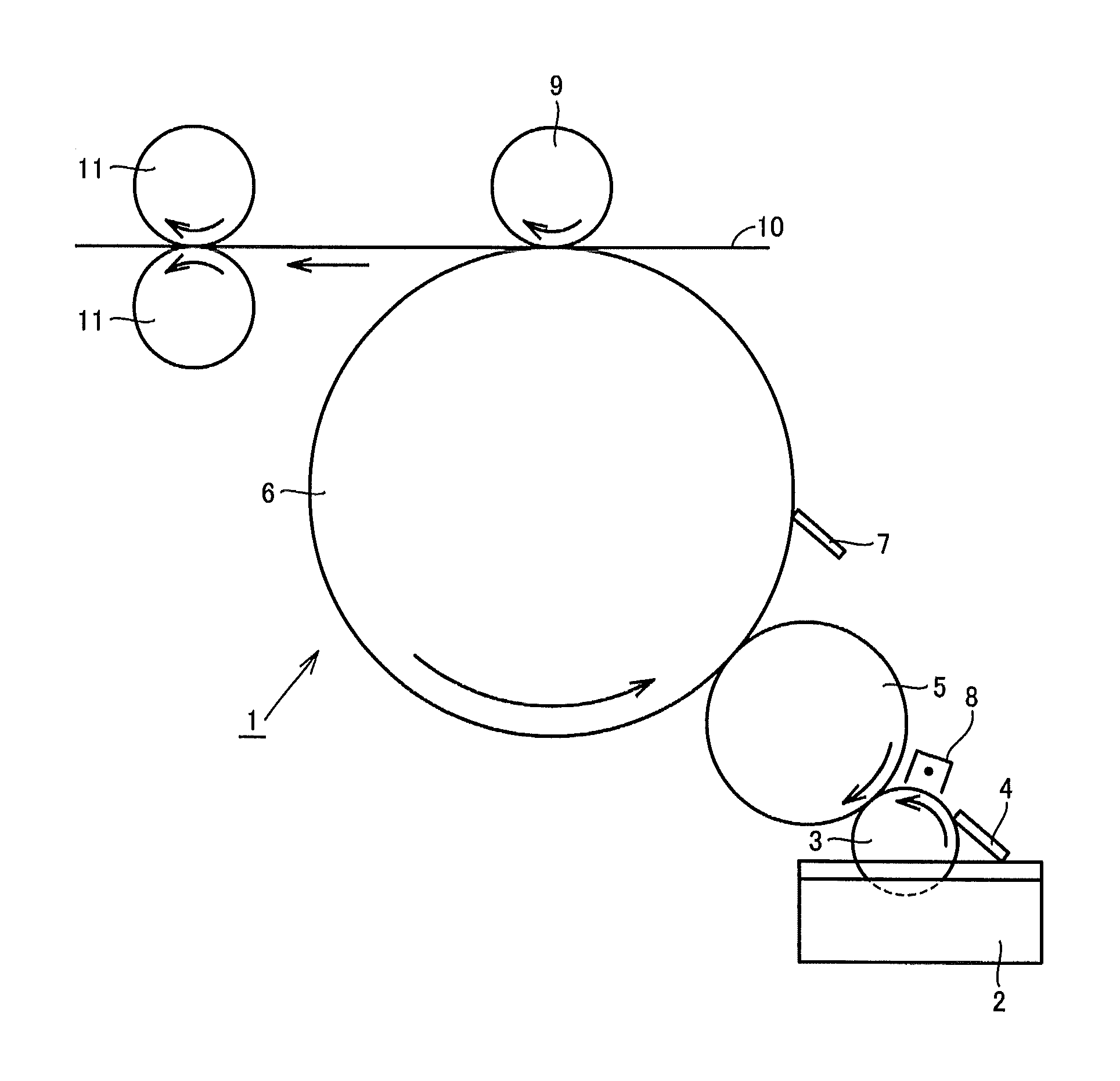Liquid developer
a liquid developer and developer technology, applied in the field of liquid developers, can solve the problems of increasing the fixing temperature, and achieve the effect of good fixation strength and without deteriorating the transfer quality
- Summary
- Abstract
- Description
- Claims
- Application Information
AI Technical Summary
Benefits of technology
Problems solved by technology
Method used
Image
Examples
example 1
[0117]220 parts of glass beads were added to: 250 parts of acetone; 54.8 parts of crystalline polyester resin (namely crystalline resin) as the resin included in the toner particles, 15.75 parts of carbon black (trademark: “Mogul L,” manufactured by Cabot Corporation) as the first pigment; 10.5 parts of C.I. Pigment Brown 25 (trademark: “PV Fast Brown HFR,” manufactured by Clariant Japan K.K.) as the second pigment; 5.25 parts of nigrosine (trademark: “TH-827,” manufactured by Orient Chemical Industries Co., Ltd.) as the third pigment; 1.05 parts of C.I. Pigment Blue 15:3 (phthalocyanine blue pigment) (trademark: “Fastogen Blue GNPT,” manufacture by DIC) as the fourth pigment; 2.45 parts of C.I. Pigment Yellow 180 (trademark: “Toner Yellow HG,” manufactured by Clariant Japan K.K.) as the fifth pigment; and 4.2 parts of pigment dispersant (trademark: “Ajisper PB-822,” manufactured by Ajinomoto Fine-Techno Co., Inc.). They were dispersed by means of a paint conditioner for three hours...
example 16
[0139]A liquid developer (the total content of the pigments in the toner particles: 20% by mass) was produced in a similar manner to Example 1 except for the changes:
[0140]250 parts of acetone;
[0141]71.6 parts of crystalline polyester resin (namely crystalline resin);
[0142]9.0 parts of carbon black (trademark: “Mogul L,” manufactured by Cabot Corporation) as the first pigment;
[0143]6.0 parts of C.I. Pigment Brown 25 (trademark: “PV Fast Brown HFR,” manufactured by Clariant Japan K.K.) as the second pigment;
[0144]3.0 parts of nigrosine (trademark: “TH-827” manufactured by Orient Chemical Industries Col, Ltd.) as the third pigment;
[0145]0.6 parts of C.I. Pigment Blue 15:3 (phthalocyanine blue pigment) (trademark: “Fastogen Blue GNPT,” manufacture by DIC) as the fourth pigment;
[0146]1.4 parts of C.I. Pigment Yellow 180 (trademark: “Toner Yellow HG,” manufactured by Clariant Japan K.K.) as the fifth pigment;
[0147]2.4 parts of pigment dispersant (trademark: “Ajisper PB-822,” manufactured...
example 17
[0149]A liquid developer (the total content of the pigments in the toner particles: 60% by mass) was produced in a similar manner to Example 1 except for the changes:
[0150]250 parts of acetone;
[0151]26.8 parts of crystalline polyester resin (namely crystalline resin);
[0152]27.0 parts of carbon black (trademark: “Mogul L,” manufactured by Cabot Corporation) as the first pigment;
[0153]18.0 parts of C.I. Pigment Brown 25 (trademark: “PV Fast Brown HER,” manufactured by Clariant Japan K.K.) as the second pigment;
[0154]9.0 parts of nigrosine (trademark: “TH-827” manufactured by Orient Chemical Industries Col, Ltd.) as the third pigment;
[0155]1.8 parts of C.I. Pigment Blue 15:3 (phthalocyanine blue pigment) (trademark: “Fastogen Blue GNPT,” manufacture by DIC) as the fourth pigment;
[0156]4.2 parts of C.I. Pigment Yellow 180 (trademark: “Toner Yellow HG,” manufactured by Clariant Japan K.K.) as the fifth pigment;
[0157]7.2 parts of pigment dispersant (trademark: “Ajisper PB-822,” manufactur...
PUM
 Login to View More
Login to View More Abstract
Description
Claims
Application Information
 Login to View More
Login to View More - R&D
- Intellectual Property
- Life Sciences
- Materials
- Tech Scout
- Unparalleled Data Quality
- Higher Quality Content
- 60% Fewer Hallucinations
Browse by: Latest US Patents, China's latest patents, Technical Efficacy Thesaurus, Application Domain, Technology Topic, Popular Technical Reports.
© 2025 PatSnap. All rights reserved.Legal|Privacy policy|Modern Slavery Act Transparency Statement|Sitemap|About US| Contact US: help@patsnap.com


